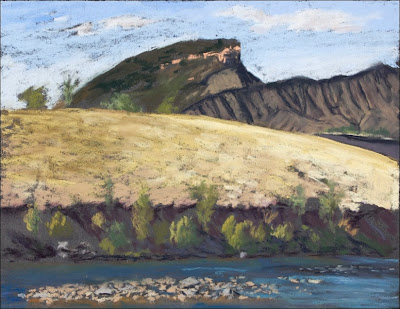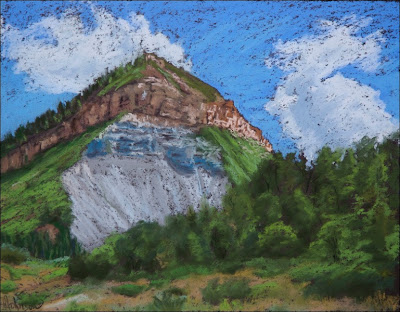What a week.
Illness, travel, spending time with friends, shared creativity, and remembering the tragic events of a decade ago all wrapped into 7 days. I'm not sure what it is about early September, but this sort of mild chaos seems to happen to me around this time of the year.
The "festivities" began last Monday afternoon, when I started feeling ill a few hours after eating something made at home with deli meat purchased shopping an hour earlier. What initially was mild nausea went on to become full-blown food poisoning within the span of 6 hrs. Thankfully, the emetic aspect of the illness only lasted a few hours, but I was left with a headache of epic proportions and a feeling that I was run over by a truck that lasted for the next 36 hrs. Aside from the fact I was unable to do anything other than lay around completely wiped out, the more concerning issue was that we were scheduled to fly to Boise on Wed morning, and it was looking like I might have to skip the trip.
However, by some stroke of healing and luck, on Wed morning, I was 90% recovered, and able to proceed with the travel plans.
Wayne's boss is currently living in Boise, and had invited Wayne out to visit and discuss some company business. When he graciously offered to buy me a ticket as well, I was thrilled, as Boise is not only a great town in itself, but it's also where my good friend and fellow artist Sarah M-B lives. Have a look at
her blog to see the amazing sculpture she does.
Before I started working in pastels and 2D landscapes about 2 years ago, I did mixed media realistic equine sculpture. Not so much sculpting, although I have done some smaller pieces, but lots of painting of resincast sculptures by other artists.
 |
"Jax" - slipcast ceramic bas-relief sculpture of jumping horse
~ 9 1/2 x 5 inches
© 2008 S Minkiewicz-Breuning
Kiln-fired ceramic glaze finishwork to chestnut sabino: S Johnson
|
This piece was actually started over 2 years ago when I was last out in Boise. Sarah hosted a mini retreat for myself and another artist, and I got as far as cleaning the greenware (unfired) clay casting, and adding the purple and blue art glazes to the fired bisque. Ever since that visit, I'd been looking forward to finishing it.
Ceramic work, and in particular the underglazing/painting process, is a fascinating and somewhat magical process to me. It is completely unlike anything else I've ever done, art-wise. Unlike cold painting methods, in which the end result is "what you see is what you get", the process of working with earth-based pigments and a ceramics kiln takes much of the control away from the artist, and it's not until you open the kiln lid 8 hours later that you have any idea what the final result will be.
The basic technique involves masking off areas that are to remain white with either tape, cellophane or Miskit. The eye is also masked.
-Next, layers of underglaze pigment mixtures are applied in a directional manner using an airbrush to accentuate shading and subtle tonal shifts, just like you see in a real horse coat, along with the gray skin areas. These pigments handle similar to watercolors, so you can't use a regular paintbrush to paint these areas or it will produce unpleasant streaks. Mistakes are very difficult, if not impossible, to fix - another thing I'm not used to when I work in oils and pastels!
-The masking is removed, and the piece is low-fired in the kiln to lightly "set" the colors, and cooled.
-An Xacto blade is used to selectively remove areas of pigment and form more intricate areas of white, such as this sabino pattern. The hitch is that you cannot handle the piece except along areas where art glaze was applied (the purple/blue rectangle) or white areas since the underglaze pigments are very fragile in this stage.
-The eye is hand-painted, in this case, blue. The hooves have a mix of hand-painting and airbrush (an experimental technique that worked very well). Pink is airbrushed for the nose and areas of white where the fur is thin and the pink often shows through. At this point, the colors are only somewhat suggestive of the flaxen chestnut color I chose, and very dull and chalky.
-Once all the work is done, layers of clear glaze are applied to the entire piece, also with the airbrush. This leaded glaze fires clear but has an opaque dye in it when applied, so that by the time the piece was ready to go into the kiln for the final fire, it was a pale pink with no visible color anywhere save for the background.
-Then, in it goes for the final firing to set the glazes. Sarah has two electric kilns, and the smaller one (named Maury) uses a very low-tech but fascinating means of reaching the proper temperature and firing time: a small stick of material, known as a
pyrometric cone, is placed in a holder within the kiln. Upon reaching the required time and temperature parameters for the particular glaze or pottery, it bends and the kiln shuts off. The process usually takes 8-12 hrs. This piece was fired at cone 06, I believe, which is considered low-fire at close to 1800 degrees F. This heat produces a chemical reaction between the clay, underglaze earth pigments and clear lead glaze to fuse them into a single layer with rich colors that are essentially unlike what was originally applied to the surface. The clear lead glaze gives a jewel-like sparkle to the final piece.
"Jax"was finished yesterday morning. Sarah excitedly came in to tell me how cool it looked, and when I saw it in the kiln, I was stunned at how different it looked, and how beautiful it turned out, especially since it is literally only the second ceramics bas-relief I've ever done.
The fact it was done as a collaboration through the strength of friendship and generosity, and came to life out of the fire on the 10th anniversary of 9/11 - an event associated with loss and destruction - gives it symbolic significance that I will never forget.
--------
On that note, it was odd actually flying home yesterday on that anniversary. In the Boise and Denver airports, it was business as usual, with passengers hustling about to their connection, or engaged in whatever activities they do to pass the time between flights. A bar TV showing the football game of the NY Jets had a memorial tribute during half-time, and it riveted people's attention. A woman sitting behind me cried as she watched it.
Here are a few photos taken during the Boise-Denver flight with Wayne's Coolpix. I like taking these photos, as they are great for taking my mind off of the irrational fears and thoughts generated by my lizard brain (amygdala) that happen while flying, particularly after take-off when the air can be bumpy. Despite this, I always try to get a window seat because I love looking out the window:
Cumulus, viewing
Farms, abstracted
Mountains, folded
Storms, forming
Clouds, entering
Denver, approaching
Highways, curving


















































